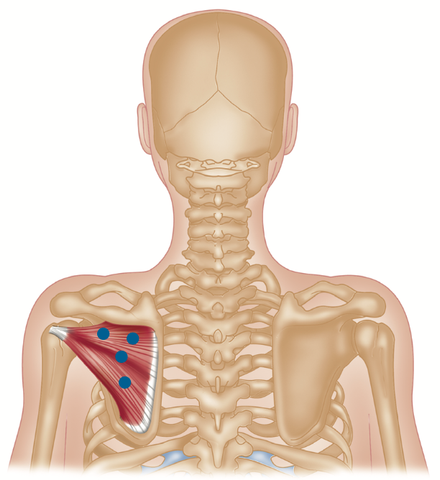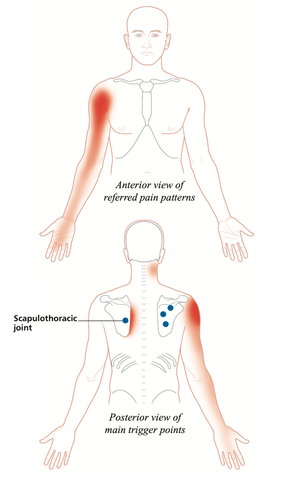The Infraspinatus Muscle: Function, Injuries, and Treatment Modalities
The infraspinatus muscle is member of the rotator cuff group, which comprises the supraspinatus, infraspinatus, teres minor, and subscapularis
The infraspinatus muscle is one of the four muscles that comprise the rotator cuff, a group of muscles and their associated tendons that stabilize the shoulder joint. Located on the posterior aspect of the scapula (shoulder blade), the infraspinatus muscle originates from the infraspinous fossa of the scapula and inserts onto the greater tubercle of the humerus. Its primary function is to externally rotate the humerus and stabilize the shoulder joint.

Insertion
Middle facet on greater tubercle of humerus. Capsule of shoulder joint.
Action
As a rotator cuff muscle, helps prevent posterior dislocation of shoulder joint. Laterally rotates humerus.
Antagonists: subscapularis, pectoralis major, latissimus dorsi.
Nerve
Suprascapular nerve, C(4), 5, 6, from upper trunk of brachial plexus.
Basic Functional Movement
Example: brushing hair back.
Referred Pain Patterns
Middle/upper cervical spine: deep anterior shoulder joint zone of
3–4 cm in region of long head of biceps brachii, radiating into biceps belly then into forearm—diffuse symptoms in median nerve distribution.
Medial/scapula: to medial border of scapula.

Indications
Decreased range of motion in Apley scratch test (behind back), hemiplegia, rotator cuff tendinopathy, frozen shoulder syndrome, pain in back and front of shoulder, night-time shoulder pain when sleeping on same/ opposite side, dead-arm sensations, pain undoing bra, shoulder girdle fatigue, weakness of grip, loss of arm strength, changes in sweating (usually increased), “mouse arm” from computer mouse overuse.
Causes
Overuse activities with arm unsupported (e.g. computer mouse, driving, tennis, weight training, water sports, ski poles), pulling objects behind body, sudden trauma from fall on outstretched arm/ catching yourself when trying to stop a fall, prolonged holding of heavy objects.
Differential Diagnosis
Biceps tendonitis. C5–C6 neuropathy. Suprascapular nerve dysfunction.
Connections
Infraspinatus, subscapularis, levator scapulae, pectoralis minor/major, long head biceps brachii, biceps brachii, anterior deltoid, teres major, latissimus dorsi, rotator cuff issues, biceps tendonitis.
References
- American Academy of Orthopaedic Surgeons
- National Institutes of Health
- Journal of Orthopaedic & Sports Physical Therapy
- Physical Therapy & Rehabilitation Journal
Disclaimer
The information provided in this article is for educational purposes only and is not intended as a substitute for professional medical advice, diagnosis, or treatment. Always seek the advice of your physician or other qualified health providers with any questions you may have regarding a medical condition. Never disregard professional medical advice or delay in seeking it because of something you have read in this article.
About Niel Asher Education
Niel Asher Education (NAT Global Campus) is a globally recognised provider of high-quality professional learning for hands-on health and movement practitioners. Through an extensive catalogue of expert-led online courses, NAT delivers continuing education for massage therapists, supporting both newly qualified and highly experienced professionals with practical, clinically relevant training designed for real-world practice.
Beyond massage therapy, Niel Asher Education offers comprehensive continuing education for physical therapists, continuing education for athletic trainers, continuing education for chiropractors, and continuing education for rehabilitation professionals working across a wide range of clinical, sports, and wellness environments. Courses span manual therapy, movement, rehabilitation, pain management, integrative therapies, and practitioner self-care, with content presented by respected educators and clinicians from around the world.
Known for its high production values and practitioner-focused approach, Niel Asher Education emphasises clarity, practical application, and professional integrity. Its online learning model allows practitioners to study at their own pace while earning recognised certificates and maintaining ongoing professional development requirements, making continuing education accessible regardless of location or schedule.
Through partnerships with leading educational platforms and organisations worldwide, Niel Asher Education continues to expand access to trusted, high-quality continuing education for massage therapists, continuing education for physical therapists, continuing education for athletic trainers, continuing education for chiropractors, and continuing education for rehabilitation professionals, supporting lifelong learning and professional excellence across the global therapy community.

Continuing Professional Education
Looking for Massage Therapy CEUs, PT and ATC continuing education, chiropractic CE, or advanced manual therapy training? Explore our evidence-based online courses designed for hands-on professionals.


















